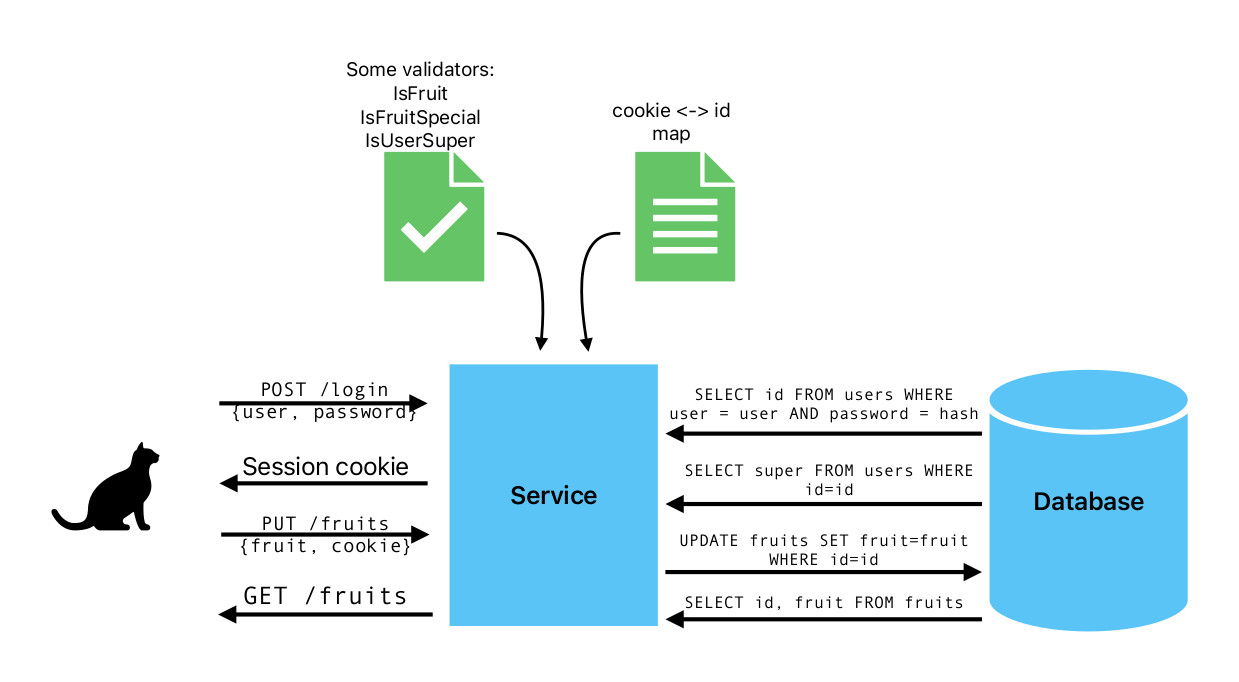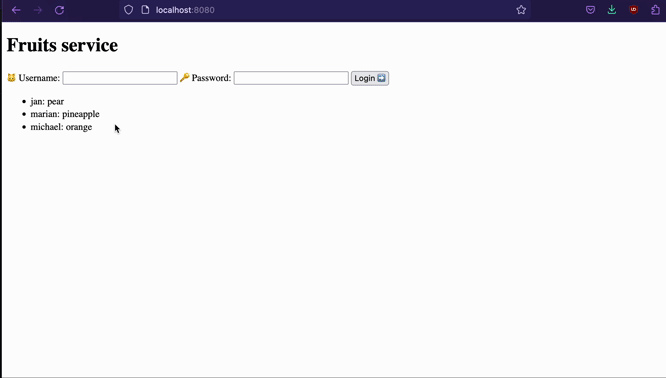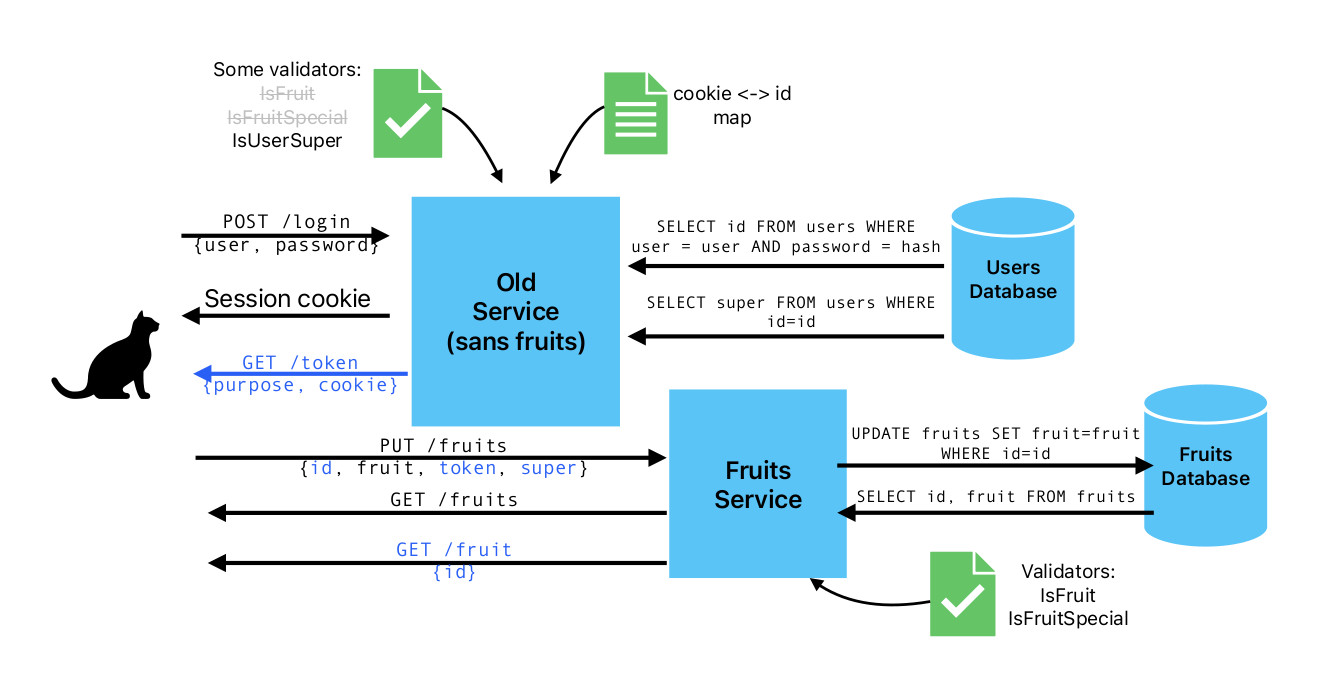Functionality Decoupling into a Microservice by a simple example
23 March 2023
This post will be more of my hypothetical deliberation on splitting a monolith. I stumbled multiple times upon a software that was logically split in code into separate modules and programs but still used the same database, often read and write from common tables. Today, using a simple example we will see how it can be separated.
First draft of the example application
Let us consider a sample application. It has a mechanism for authentication, authorization of users as well as some fields that can be updated by the user. The user will be described by the following schema:
type User struct {
ID int64 // Typical ID
Name string // Some username, can be e-mail
Password string // Password hash
Super bool // Account status - premium/gold however you call it
}
What is more, the user can choose their favorite fruit in another table but the
list is predefined and Super user is the only one that can select pineapple.
type Fruit struct {
ID int64 // Foreign key ID
Name string // Name of the fruit
}
The constraints can be hardcoded into the application using if statements or a
list kept in some config file. In the example below, the functions
IsFruit, IsFruitSpecial and InsertOrUpdateFruit are implemented
"somewhere".
// on: PUT into /fruits
func (u *User) UpdateFruit(fruit String) error {
if ! IsFruit(fruit) {
return fmt.Errorf("Fruit %s is not in the list of available fruits!", fruit)
}
if u.Super && IsFruitSpecial(fruit) {
return fmt.Errorf("Only Super users can select special fruits like %s!", fruit)
}
return InsertOrUpdateFruit(u.ID, fruit)
}
To put it into rough graphics, that is how our application looks like currently:

First version of the monolith service
Follow to this repository to access
the first version of our service. (It's just an example, there is a lot to
improve there!)
Use Go to build it with go build and run ./monolith to use it. Create some
users with:
$ ./monolith -username user1 -password password123
The first user you create will have ID = 1 and have no super status. Each next user will have ID incremented by 1 and will also have no super status. By default there are no fruits set.
Default SQLite database name is monolith.db in the current working directory.
You can switch each user's status using these commands (where 1 is the user ID):
$ ./monolith -super 1
$ ./monolith -unsuper 1
To start the server on port :8080, use ./monolith -serve. Then you can
access the website in your browser using http://localhost:8080. Users should
be able to log in and set their favorite fruit from the combo box. Fruits marked
with asterisk (*) are special and can only be used by super users.

Code of this service is categorized between different directories:
usershandles user creation, setting status, checking status, session creation, verification and deletion,fruitshandles fruit setting, listing the fruits and checking if the fruit is special. It is currently tightly coupled with theuserspackage, due toJOINstatement when showing the fruits (mapping user ID to username),routerhandles the routing HTTP endpoints, session activation based on cookie, redirects, etc. It uses function from bothusersandfruits.mainfile is fortunately not referencing anything from thefruitspackage. It only calls therouterto serve the website, create users and set their status.
Our goal is to decouple the fruits from the entire codebase and make it a new
microservice that can run independently.
Target structure
So, our plan is to split up the application into the old monolith and a new microservice that will handle favorite fruits. The new microservice will have two functions - getting the list of all fruits of all users, changing user's favorite fruit based on authorization token, and we will extend it with function of getting fruit of a single user.
What is more the new microservice will implement the functions for checking if the input is an actual fruit and if the selected fruit can be set by the user.
The old monolith service will be still responsible for user and session management but also for generating a token (see next paragraph).

How will the fruits service know if the user is authenticated or super?
Here comes the magic of cryptography. For this matter we will use JSON Web Token that is a base64 encoded JSON object along with a cryptographic signature. Only the old accounts service will be able to sign the token with its private key. Then fruits service will use the old service's public key to verify the token's validity. Even though we use cryptography here, data in the tokens is not encrypted (potentially only in transit with TLS). Stealing the token from the user is as risky as stealing session cookie. However, signature protects the token from being manipulated, so we will include an expiration time in it.
// Inside accounts/old service
func CreateToken(id int, super bool) (string, error) {
// Create a custom token with our needed fields
claims := struct {
UserId int
Super bool
jwt.StandardClaims
}{
id,
super,
jwt.StandardClaims{
ExpiresAt: time.Now().Unix() + 10, // 10 seconds
},
}
// Generate the token structure and sign it with Ed25519
token := jwt.NewWithClaims(jwt.SigningMethodEdDSA, claims)
return token.SignedString(private_key)
}
// Inside fruits/new service
func VerifyToken(token string) (int, bool, error) {
claims := struct {
UserId int
Super bool
jwt.StandardClaims
}{}
// Parse the JSON object into the struct and verify the signature with public key
_, err := jwt.ParseWithClaims(token, &claims, func(token *jwt.Token) (interface{}, error) {
if _, ok := token.Method.(*jwt.SigningMethodEdDSA); !ok {
return nil, fmt.Errorf("Not today, Mr Robot, no use for: %v", token.Header["alg"])
}
return public_key, nil
})
if err != nil {
return 0, false, err
}
return claims.UserId, claims.Super, nil
}
Possible problems with this approach
The first problem that is obvious is that querying fruits it tightly coupled
with the users table because of the JOIN statement. There are multiple
possibilities to solve this problem:
- Denormalization 145 - store username along ID and selected fruit.
This is by far the simplest approach. However, what if user changes the
username? We would need to also update it in the fruits table. We can create
an endpoint in the new microservice and instruct the old monolith part to call
it when the username changes. But this solution breaks the idea of being
loosely coupled and independent operation of microservices when one of the
services is down. The only way here would be to emit a message to a message
broker and hope that it will be picked up by
fruitsservice. - Query the old service from the
fruitsservice or query the newfruitsmicroservice from the old monolith. Again, this goes against independence of the services when one of them is down. We don't want to show 503 errors too often. Also the amount of requests can become unmanageable if the lists are large. Chatty communication can lead to tight coupling. 2 - Create a third service that will be responsible for joining together the
list of fruits and users. This seems like a good solution. That way business
logic will be kept within boundaries of
usersandfruitsmicroservices, whilerouterwill be transformed into a proxy with some presentation logic. But in case the list of users and/or fruits is large, that it doesn't fit into memory, and we would need multiple calls to fetch the data, this issue will become complex and require caching implementation to keep the performance to the maximum. 36
Another problem with this design is when we want to create a bugfix that removes
the fruit setting from the table based on up-to-date user's status. For example,
what if the user suddenly becomes not super? In a monolith, setting the logic
might would be simpler - just query fruits table and verify if the selection
is still valid. For the microservice, we will need to somehow notify the fruits
service about the change. This might be immediate or scheduled, for example once
per day make synchronization between two services. However, this causes us to
need to implement another interface. We can also use a message broker like
RabbitMQ, broadcast the change from the accounts service and let fruits service
poll the topic, just like in the first solution.
In the next post, we will go through the process of decoupling the service using
the first approach. We will store displayName along with the user's id and
fruit choice.
-
3. Splitting the monolith: Performance, Data Integrity. in Sam Newman, Building Microservices, page 81. ↩
-
2. How to model Microservices: Coupling. in Sam Newman, Building Microservices, page 38. ↩
-
Table-table join. in Martin Kleppmann, Designing Data-Intensive Applications, page 474. ↩
-
Reduce-Side Joins in Martin Kleppmann, Designing Data-Intensive Applications, page 403. ↩
-
2. Data Models and Query Languages. in Martin Kleppmann, Designing Data-Intensive Applications, page 34. ↩
-
Broadcast hash joins in Martin Kleppmann, Designing Data-Intensive Applications, page 409. ↩